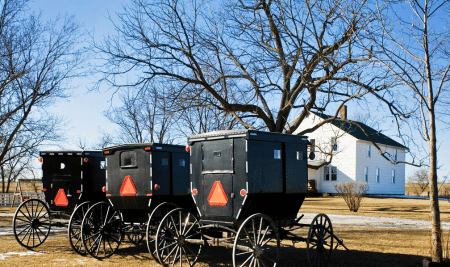The US Supreme Court Case Wisconsin v. Yoder, decided in 1972, ruled that compulsory high school education was not required for those whose religious beliefs did not support a full education, in this instance being the Amish. This case has allowed hundreds of children to suffer from under-education, and is still today shrouded in misinformation and ignorance.
Here are three common myths that still circulate today surrounding Wisconsin v. Yoder:
#1: Wisconsin v. Yoder is a case fighting for religious freedom rights
Wisconsin v. Yoder is a case about religious freedom, right? Everyone has the right to raise their children by their own religion!
When discussing Wisconsin v. Yoder, many believe that the case is a landmark victory for religious freedom rights in America. On the surface, Wisconsin v. Yoder seems to just be Amish parents fighting for the right for their children to not be forced into the secular world at such an impressionable age. When arguing the case, this is the exact stance that Yoder and his counsel took. By portraying the issue at hand as an honorable struggle for religious freedom, Yoder’s side was able to create a more sympathetic case for depriving thousands of children of a full education.
However, this take ignores the truth behind what Yoder’s side was truly fighting for. Wisconsin v. Yoder allowed for the chronic under-education of a whole population of Amish children, making them completely dependent on the Amish church and community and isolating them from any resources within secular society. This also allowed Amish parents to “train” their children on their farms under the guise of hands-on agricultural education, when truthfully they are being used as unpaid child labor. The decision in Wisconsin v. Yoder was not about freedom, but the opposite, control- control of children’s labor and potential to succeed outside.
Furthermore, Wisconsin v. Yoder today is used to further push the agenda of “religious freedom” by Christian right-wing political communities, despite the fact that the Amish are apolitical. The fact that the case is used as a staple argument and precedent for non-Amish religious groups with a clear political agenda shows just how the case was never about Amish freedom of religion in the first place. Wisconsin v. Yoder has always been about hidden agendas and control, Amish or not.
#2: In making the decision for Wisconsin v. Yoder, the court consulted the children involved in the case directly
Well, even if the decision of Wisconsin v. Yoder was influenced by outside agendas, at least the children were consulted, right? And no child really wants to go to school!
Well, not exactly.
Out of the multiple children involved in Wisconsin v. Yoder, only one, Frieda Yoder, testified. In her testimony, she was only asked if her religion was the reason she did not go to school––not if she wanted to go to school despite her religion, or any question pertaining to her own wishes for her future.
Only one of the children testified. The last two questions and answers on her cross-examination accurately sum up her testimony:
QUESTION: So I take it then, Frieda, the only reason you are not going to school, and did not go to school since last September, is because of your religion?
ANSWER: Yes.
QUESTION: That is the only reason?
ANSWER: Yes. (Emphasis supplied.)
Even if Frieda was asked about her own hopes for her future, there is no guarantee that she would be able to answer honestly. She likely would have feared social backlash from her parents and community at large if she made a stand for her right to a full education. Without the skills to survive outside the church, it is incredibly dangerous for a child to rebel and fight for an education and face losing the support of their community.
#3: Even without the right to a high school education, Amish children still have the potential to live a successful life
Even if Amish children don’t get a full education, they’re trained in agriculture at home, so they still have the skills to be successful!
One justification of the Wisconsin v. Yoder decision is the hands-on agricultural training that Amish children receive as an alternative to a traditional high school education. While this may prepare them for an Amish lifestyle, it restricts them from any potential to create a future outside of the Amish community. While some may be able to escape and create a life for themselves, this comes at a cost; Amish escapees struggle to adapt to the modern world and learn basic skills, leading to issues like poverty and mental health struggles.
Effectively, the Wisconsin v. Yoder decision ensures that Amish children have no other option than to stay within the Church. Without the skills to survive in modern society, they are stuck within their communities, creating a cycle of under-educated children being unable to reach their full potential.
To education,
A.A.
Summer Intern, Amish Heritage Foundation



